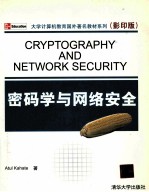
- 作 者:卡哈特(ATUL KAHATE)著
- 出 版 社:
- 出版年份:2005
- ISBN:
- 标注页数:0 页
- PDF页数:454 页
请阅读订购服务说明与试读!
订购服务说明
1、本站所有的书默认都是PDF格式,该格式图书只能阅读和打印,不能再次编辑。
2、除分上下册或者多册的情况下,一般PDF页数一定要大于标注页数才建议下单购买。【本资源454 ≥0页】
图书下载及付费说明
1、所有的电子图书为PDF格式,支持电脑、手机、平板等各类电子设备阅读;可以任意拷贝文件到不同的阅读设备里进行阅读。
2、电子图书在提交订单后一般半小时内处理完成,最晚48小时内处理完成。(非工作日购买会延迟)
3、所有的电子图书都是原书直接扫描方式制作而成。
1.Introduction to the Concepts of Security 1
1.1 Introduction 1
1.2 TheNeed for Security 2
1.3 Security Approaches 3
1.4 Principles of Security 4
1.5 Types of Attacks 8
Outline of the Book 23
Multiple-choice Questions 25
Review Questions 26
Design/Programming Exercises 27
2.Cryptographic Techniques 28
2.1 Introduction 28
2.2 Plain Text and CipherText 29
2.3 Substitution Techniques 31
2.4 Transposition Techniques 36
2.5 Encryption and Decryption 40
2.6 Symmetric and Asymmetric Key Cryptography 43
2.7 Steganography 53
2.8 Key Range and Key Size 54
2.9 Possible Types of Attacks 57
Chapter Summary 58
Key Terms and Concepts 59
Multiple-choice Questions 59
Review Questions 60
Design/Programming Exercises 61
3.Computer-based Symmetric Key Cryptographic Algorithms 63
3.1 Introduction 63
3.2 Algorithm Types and Modes 63
3.3 An Overview of Symmetric Key Cryptography 73
3.4 DataEncryption Standard(DES) 75
3.5 International Data Encryption Algorithm(IDEA) 90
3.6 RC5 98
3.7 Blowfish 105
3.8 Advanced Encryption Standard(AES) 107
3.9 Differential and Linear Cryptanalysis 109
Chapter Summary 110
Key Terms and Concepts 110
Multiple-choice Questions 110
Review Questions 111
Design/Programming Exercises 111
4.Computer-based Asymmetric Key Cryptographic Algorithms 112
4.1 Introduction 112
4.2 Brief History of Asymmetric Key Cryptography 112
4.3 An Overview of Asymmetric Key Cryptography 113
4.4 The RSA Algorithm 115
4.5 Symmetric and Asymmetric Key Cryptography Together 119
4.6 Digital Signatures 125
4.7 Knapsack Algorithm 154
4.8 Some other Algorithms 154
Chapter Summary 157
Key Terms and Concepts 158
Multiple-choice Questions 158
Review Questions 159
Design/Programming Exercises 159
5.Public Key Infrastructure(PKI) 161
5.1 Introduction 161
5.2 Digital Certificates 162
5.3 Private Key Management 194
5.4 The PKIX Model 196
5.5 Public Key Cryptography Standards(PKCS) 198
5.6 XML,PKI and Security 204
Chapter Summary 208
Key Terms and Concepts 208
Multiple-choice Questions 209
Review Questions 210
Design/Programming Exercises 210
6.Internet Security Protocols 211
6.1 Basic Concepts 211
6.2 Secure Socket Layer(SSL) 218
6.3 Secure Hyper Text Transfer Protocol(SHTTP) 229
6.4 Time Stamping Protocol(TSP) 230
6.5 Secure Electronic Transaction(SET) 231
6.6 SSL Versus SET 244
6.7 3-D Secure Protocol 244
6.8 Electronic Money 245
6.9 Email Security 250
6.10 Wireless Application Protocol(WAP)Security 263
6.11 Securityin GSM 266
Chapter Summary 268
Key Terms and Concepts 269
Multiple-choice Questions 269
Review Questions 270
Design/Programming Exercises 270
7.User Authentication Mechanisms 271
7.1 Introduction 271
7.2 Authentication Basics 271
7.3 Passwords 272
7.4 Authentication Tokens 286
7.5 Certificate-based Authentication 297
7.6 Biometric Authentication 303
7.7 Kerberos 304
7.8 Single Sign On(SSO)Approaches 309
Chapter Summary 310
Key Terms and Concepts 311
Multiple-choice Questions 311
Review Questions 312
Design/Programming Exercises 312
8.Practical Implementations of Cryptography/Security 314
8.1 Cryptographic Solutions Using Java 314
8.2 Cryptographic Solutions Using Microsoft 322
8.3 Cryptographic Toolkits 324
8.4 Security and Operating Systems 325
Chapter Summary 330
Key Terms and Concepts 330
Multiple-choice Questions 330
Review Questions 331
Design/Programming Exercises 331
9.Network Security 332
9.1 Brief Introduction to TCP/IP 332
9.2 Firewalls 338
9.3 IPSecurity 349
9.4 Virtual Private Networks(VPN) 365
Chapter Summary 368
Key Terms and Concepts 368
Multiple-choice Questions 369
Review Questions 369
10.Case Studies on Cryptography and Security 371
10.1 Introduction 371
10.2 Cryptographic Solutions—A Case Study 371
10.3 Single Sign On(SSO) 379
10.4 Secure Inter-branch Payment Transactions 382
10.5 Denial of Service(DOS)Attacks 385
10.6 IP Spoofing Attacks 388
10.7 Cross Site Scripting Vulnerability(CSSV) 389
10.8 Contract Signing 391
10.9 Secret Splitting 392
10.10 Virtual Elections 394
10.11 Secure Multiparty Calculation 395
Appendix A—Mathematical Background 396
Appendix B—Number Systems 401
Appendix C—Information Theory 406
Appendix D—Real-life Tools 408
Appendix E—Web Resources 409
Appendix F—A Brief Introduction to ASN,BER,DER 411
Appendix G—Modern Security Trends 413
Answers to Multiple-choice Questions 419
Glossary 420
References 426
Index 428
